Note
Go to the end to download the full example code
ERT field data with topography#
Simple example of data measured over a slagdump demonstrating:
2D inversion with topography
geometric factor generation
topography effect
import pygimli as pg
from pygimli.physics import ert
Get some example data with topography, typically by a call like data = ert.load(“filename.dat”) that supports various file formats
data = pg.getExampleFile('ert/slagdump.ohm', load=True, verbose=True)
print(data)
[:::::::::::::::::::::::::::::::::::: 100% ::::::::::::::::::::::::::::::::::::] 5435 of 5435 complete
md5: f27293809709e8fdc89bfb0a55e6e1ec
Data: Sensors: 38 data: 222, nonzero entries: ['a', 'b', 'm', 'n', 'r', 'valid']
The data file does not contain geometric factors (token field ‘k’), so we create them based on the given topography.
data['k'] = ert.createGeometricFactors(data, numerical=True)
We initialize the ERTManager for further steps and eventually inversion.
mgr = ert.ERTManager(sr=False)
It might be interesting to see the topography effect, i.e the ratio between the numerically computed geometry factor and the analytical formula
k0 = ert.createGeometricFactors(data)
ert.showData(data, vals=k0/data['k'], label='Topography effect')
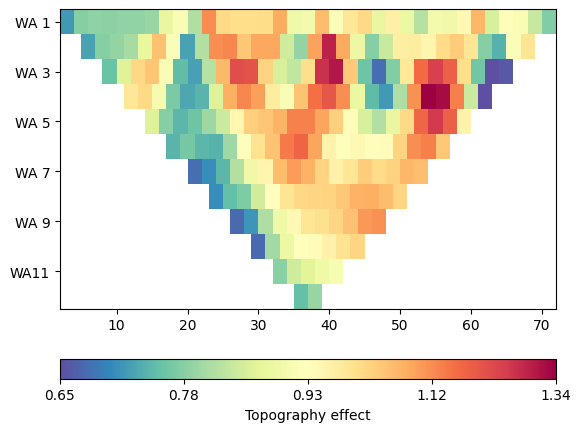
(<AxesSubplot:>, <matplotlib.colorbar.Colorbar object at 0x7fbe8a2deb90>)
The data container has no apparent resistivities (token field ‘rhoa’) yet. We can let the Manager fix this later for us (as we now have the ‘k’ field), or we do it manually.
mgr.checkData(data)
print(data)
Data: Sensors: 38 data: 222, nonzero entries: ['a', 'b', 'k', 'm', 'n', 'r', 'rhoa', 'valid']
The data container does not necessarily contain data errors data errors (token field ‘err’), requiring us to enter data errors. We can let the manager guess some defaults for us automaticly or set them manually
data['err'] = ert.estimateError(data, absoluteUError=5e-5, relativeError=0.03)
# or manually:
# data['err'] = data_errors # somehow
ert.show(data, data['err']*100)
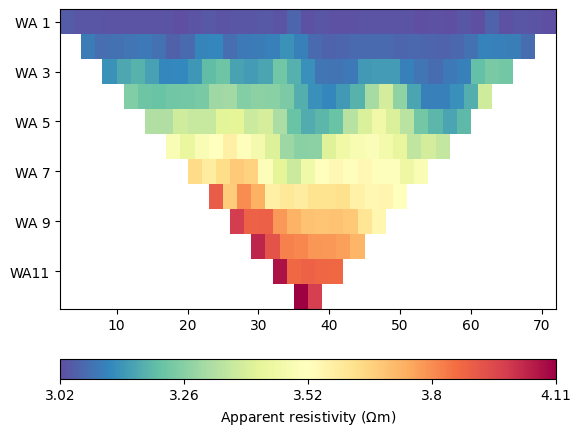
(<AxesSubplot:>, <matplotlib.colorbar.Colorbar object at 0x7fbe89322530>)
Now the data have all necessary fields (‘rhoa’, ‘err’ and ‘k’) so we can run the inversion. The inversion mesh will be created with some optional values for the parametric mesh generation.
mod = mgr.invert(data, lam=10, verbose=True,
paraDX=0.3, paraMaxCellSize=10, paraDepth=20, quality=33.6)
mgr.showResult()
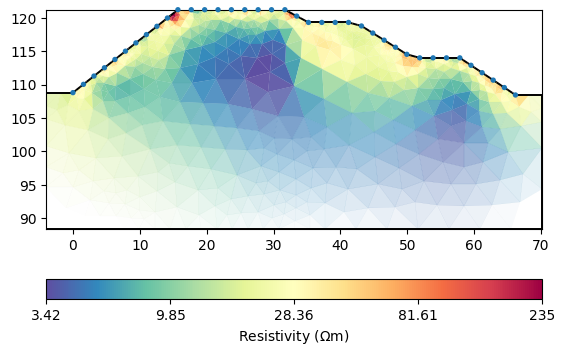
fop: <pygimli.physics.ert.ertModelling.ERTModelling object at 0x7fbe79595080>
Data transformation: <pygimli.core._pygimli_.RTransLogLU object at 0x7fbe79594bd0>
Model transformation: <pygimli.core._pygimli_.RTransLog object at 0x7fbe79594e00>
min/max (data): 6.07/33.48
min/max (error): 3.02%/4.11%
min/max (start model): 10.65/10.65
--------------------------------------------------------------------------------
inv.iter 0 ... chi² = 198.16
--------------------------------------------------------------------------------
inv.iter 1 ... chi² = 16.18 (dPhi = 90.28%) lam: 10.0
--------------------------------------------------------------------------------
inv.iter 2 ... chi² = 1.58 (dPhi = 80.44%) lam: 10.0
--------------------------------------------------------------------------------
inv.iter 3 ... chi² = 1.01 (dPhi = 11.83%) lam: 10.0
--------------------------------------------------------------------------------
inv.iter 4 ... chi² = 0.98 (dPhi = 0.52%) lam: 10.0
################################################################################
# Abort criterion reached: chi² <= 1 (0.98) #
################################################################################
(<AxesSubplot:>, <matplotlib.colorbar.Colorbar object at 0x7fbe7b203640>)
We can view the resulting model in the usual way.
mgr.showResultAndFit()
# np.testing.assert_approx_equal(ert.inv.chi2(), 1.10883, significant=3)
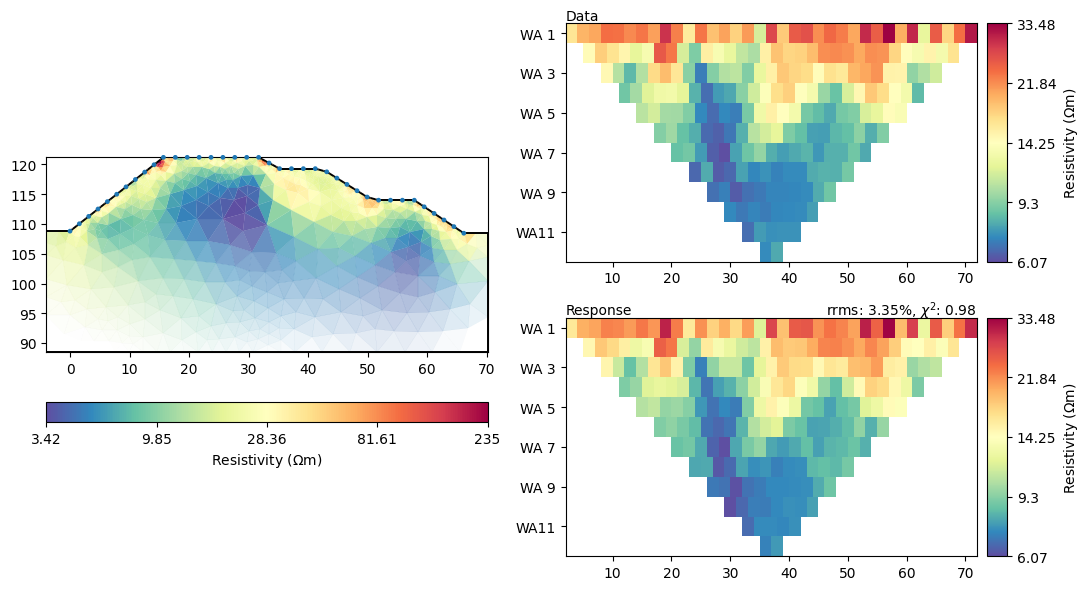
<Figure size 1100x600 with 6 Axes>
Or just plot the model only using your own options.
mgr.showResult(mod, cMin=5, cMax=30, cMap="Spectral_r", logScale=True)
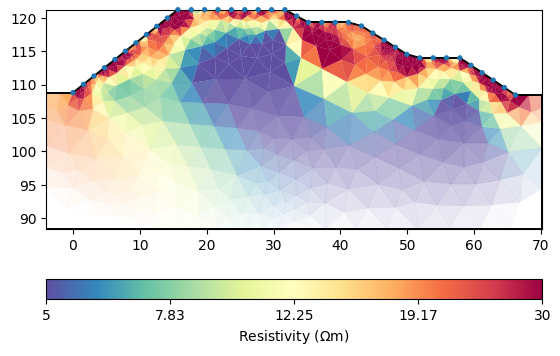
(<AxesSubplot:>, <matplotlib.colorbar.Colorbar object at 0x7fbe780ce530>)
Total running time of the script: ( 0 minutes 13.972 seconds)